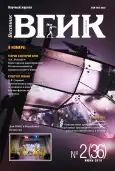Film Art Against Avant-Garde? On the Onthology of Artistic Means
- Authors: Yakimovich A.K1
-
Affiliations:
- Institute of History and Theory of Arts of the Russian Academy of Arts
- Issue: Vol 10, No 2 (2018)
- Pages: 8-26
- Section: THEORY AND HISTORY OF CINEMA | AUDIOVISUAL ARTS
- URL: https://journals.eco-vector.com/2074-0832/article/view/14570
- DOI: https://doi.org/10.17816/VGIK1028-26
- ID: 14570
Cite item
Full Text
Abstract
The first decade of the 20th century witnessed two revolutions in the world of arts: firstly, the upcoming of Avant-Garde art, and secondly - the birth of cinematic art. In painting, architecture and literature new revolutionary languages actually finalized the process of “onthologisation” which has begun much earlier. ttis process signaled its appearance with Modernity itself and reached its climax in the late 19 th century. We can observe since then a new species of artists whose artworks actually defy ideological meanings. Meanings and messages of artworks clearly distance themselves from convictions shared by authors. Visual and verbal arts as well as important strata of musical and theatrical productions embrace the discourse of Nature and Universe (i. e. primary components of Being). Avant-garde art makes the final accent in this development of Modernity. tte newly born film art seems to compensate functions ignored or denied by other artistic activities. Cinematic productions start realizing the «human and cultural tasks” (ideological propaganda, sentimental comfort, entertainment and other social functions). Elite-bound taste and high cultural pretentions seemingly fall out in early cinema. tte break-through in film art reaches its peak around 1910 parallel to the upheaval of Early Avant-Garde in painting. Handling of camera, constructing of visual field, as well as experimental boundlessness in space-and-time transformations bring the socially acceptable film narrative to the kind of onthological explosion on screen. In fact, film language itself (independently from any ideology or sociability) develops new methods of seeing. A decade before film art would enter its stormy “marriage” with Surrealism, masters of the screen already detected ways of hypnotic charm and irrational hurricane passing before our eyes. As examples of such inherent onthologization of means in film art we can see the structure itself of the “picture” and deliriumlike narration in several early films, i. e. Cabiria directed by Italian Giovanni Pastrone in 1914 as well as American masterpiece of 1915 - The Birth of a Nation by D.W. Griffith.
Keywords
Full Text
Abstract: The first decade of the 20th century witnessed two revolutions in the world of arts: firstly, the upcoming of Avant-Garde art, and secondly — the birth of cinematic art. In painting, architecture, and literature new revolutionary languages actually finalized the process of “onthologisation” which has begun much earlier. This process signaled its appearance with Modernity itself and reached its climax in the late 19th century. We can observe since then a new species of artists whose artworks actually defy ideological meanings. Meanings and messages of artworks clearly distance themselves from convictions shared by authors.
Visual and verbal arts as well as important strata of musical and theatrical productions embrace the discourse of Nature and Universe (i. e. primary components of Being). Avant-garde art makes the final accent in this development of Modernity. The newly born film art seems to compensate functions ignored or denied by other artistic activities. Cinematic productions start realizing the «human and cultural tasks” (ideological propaganda, sentimental comfort, entertainment and other social functions). Elitebound taste and high cultural pretentions seemingly fall out in the early cinema. The break-through in film art reaches its peak around 1910 parallel to the upheaval of Early Avant-Garde in painting. Handling of a camera, constructing of the visual field, as well as experimental boundlessness in space-and-time transformations bring the socially acceptable film narrative to the kind of onthological explosion on screen. In fact, film language itself (independently from any ideology or sociability) develops new methods of seeing. A decade before film art would enter its stormy “marriage” with Surrealism, masters of the screen already detected ways of hypnotic charm and irrational hurricane passing before our eyes. As examples of such inherent onthologization of means in film art we can see the structure itself of the “picture” and deliriumlike narration in several early films, i. e. Cabiria directed by Italian Giovanni Pastrone in 1914 as well as the American masterpiece of 1915 — The Birth of aNation by D.W. Griffith.
About the authors
Alexander K Yakimovich
Institute of History and Theory of Arts of the Russian Academy of Arts
Author for correspondence.
Email: editor@vestnik-vgik.com
Doctor of Arts, Academician of the Russian Academy of Arts Chief editor, “Sobraniye. Iskusstvo & kultura”.
Russian Federation, MoscowReferences
- Прокофьев В. Об искусстве и искусствознании. Статьи разных лет. - М.: Советский художник, 1985. - 304 с.
- Разлогов К. Мировое кино. История искусства экрана. - М.: Эксмо, 2013. - 288 с.
- Разлогов К. Искусство экрана. От синематографа до Интернета. - М.: Росспэн, 2010. - 304 с.
- Якимович А. Искусство непослушания. Вольные беседы о свободе творчества. - СПб.: Дмитрий Буланин, 2011. - 288 с.
- Якимович А. Эпоха сокрушительных творений. Из истории искусства и мысли 20 века. - М.: Галарт, 2009. - 288 с.
- Ямпольский М. Видимый мир. Очерки ранней кинофеноменологии. - М.: Киноведческие записки, 1993. - 216 с.
- Thompson K., Bordwell D. Film History: An Introduction. 2nd Ed. N.Y. McGraw-Hill, 2003. - 857 p.
- Gunning T. D.W. Griffith and the Origins of American Narrative Film. Urbana and Chicago: Univ. of Illinois Press, 1991. - 316 p.
- Bowser E. The Transformation of Cinema. 1907-1915. - N.Y.: Scribner, 1990.
Supplementary files








